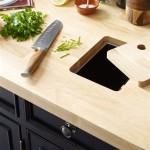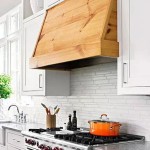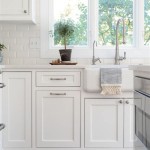Sea Glass Tile Kitchen Backsplash: A Comprehensive Guide
The kitchen backsplash serves as more than a protective barrier against splashes and spills; it is a prominent design element that can significantly enhance the aesthetic appeal of the entire kitchen. Among the various materials available for backsplash construction, sea glass tile stands out for its unique texture, translucent beauty, and ability to evoke a sense of coastal tranquility. This article provides a detailed exploration of sea glass tile backsplashes, encompassing their characteristics, installation considerations, design possibilities, and maintenance requirements.
Sea glass itself is formed through the natural process of wave action and erosion acting upon discarded glass fragments. Over time, the sharp edges of the glass are smoothed, and the surface becomes frosted, resulting in the distinctive appearance that defines sea glass. While genuine sea glass can be incorporated into tile designs, it is more common to find manufactured sea glass tiles, which are created to replicate the look and feel of authentic sea glass. This allows for greater consistency in color, size, and shape, making manufactured sea glass a more practical and readily available option for tile installations.
Understanding Sea Glass Tile Characteristics
Sea glass tile offers a multitude of benefits that make it a desirable choice for kitchen backsplashes. Its aesthetic appeal is undeniable. The soft, muted colors, often ranging from calming blues and greens to subtle whites and browns, create a serene and inviting atmosphere. The inherent translucence of the glass allows light to filter through, adding depth and dimension to the backsplash. This is particularly effective in kitchens with limited natural light, as the sea glass tiles can help to brighten the space.
Beyond its visual attributes, sea glass tile is also relatively durable and easy to maintain. The glass surface is resistant to stains and water damage, making it well-suited for the demands of a kitchen environment. Regular cleaning with a mild detergent and water is typically sufficient to keep the backsplash looking its best. However, it is important to note that sea glass tile, like any glass product, can be susceptible to scratching or chipping if subjected to harsh impacts. Therefore, it is advisable to avoid using abrasive cleaners or scouring pads that could potentially damage the surface.
The availability of sea glass tile in various shapes and sizes provides ample design flexibility. Common options include square, rectangular, and mosaic tiles, allowing for a wide range of patterns and layouts. The tiles can be arranged in a simple grid pattern for a clean and contemporary look, or they can be combined with other materials, such as natural stone or ceramic tile, to create more complex and visually interesting designs. The versatility of sea glass tile makes it compatible with a variety of kitchen styles, from coastal and cottage-inspired designs to modern and minimalist aesthetics.
Installation Considerations for Sea Glass Tile Backsplashes
The installation of a sea glass tile backsplash requires careful planning and execution to ensure a professional and long-lasting result. While experienced homeowners may be able to tackle the project themselves, it is often recommended to hire a qualified tile installer, particularly for larger or more intricate installations. The substrate, or the surface to which the tiles will be adhered, must be clean, flat, and structurally sound. Any existing imperfections, such as cracks or unevenness, should be addressed before beginning the tile installation process.
Selecting the appropriate adhesive, or thin-set mortar, is crucial for ensuring a strong and durable bond between the tiles and the substrate. A white thin-set mortar is often preferred for sea glass tile installations, as it will not affect the color of the glass. It is important to follow the manufacturer's instructions for mixing and applying the thin-set mortar, paying close attention to the recommended water-to-powder ratio and the curing time. The tiles should be carefully placed and pressed into the mortar, ensuring that they are properly aligned and spaced.
Grouting is an essential step in the tile installation process, as it fills the gaps between the tiles and creates a waterproof seal. A sanded grout is typically recommended for sea glass tile backsplashes, as it provides better adhesion and durability. The grout should be applied evenly and thoroughly, ensuring that all the joints are completely filled. Excess grout should be removed promptly with a damp sponge, and the tiles should be cleaned thoroughly to remove any residual grout haze. Sealing the grout is highly recommended to protect it from stains and moisture damage. A penetrating sealer can be applied after the grout has cured completely, according to the manufacturer's instructions.
Exploring Design Possibilities with Sea Glass Tile
Sea glass tile offers a vast array of design possibilities, allowing homeowners to create a backsplash that reflects their personal style and complements the overall aesthetic of their kitchen. The color palette of sea glass is inherently calming and versatile, making it easy to coordinate with a wide range of cabinet colors, countertop materials, and flooring options. For a classic coastal look, consider pairing sea glass tiles in shades of blue and green with white cabinets, light-colored countertops, and natural wood accents.
Mixing different shapes and sizes of sea glass tile can add visual interest and texture to the backsplash. For example, a combination of square and rectangular tiles in varying shades of blue can create a dynamic and eye-catching pattern. Mosaic tiles, which consist of small pieces of glass arranged on a mesh backing, offer even greater design flexibility. Sea glass mosaic tiles can be used to create intricate patterns, such as geometric designs or floral motifs. They can also be used as accent pieces, adding pops of color and texture to a more subdued backsplash design.
Integrating sea glass tile with other materials, such as natural stone or ceramic tile, can create a unique and personalized backsplash design. For example, a strip of sea glass mosaic tile can be incorporated into a backsplash made of subway tile to add a touch of coastal charm. Natural stone tiles, such as travertine or marble, can provide a contrasting texture and color, creating a visually appealing juxtaposition. When combining different materials, it is important to consider the overall color scheme and design aesthetic to ensure a cohesive and harmonious result.
Lighting plays a crucial role in enhancing the beauty of a sea glass tile backsplash. Under-cabinet lighting can highlight the translucent quality of the glass, creating a warm and inviting glow. Pendant lights can be strategically placed to illuminate the backsplash and provide task lighting for food preparation. The type of lighting used, whether it is warm or cool, can also affect the overall mood of the kitchen. Warmer lighting can create a cozy and inviting atmosphere, while cooler lighting can create a more modern and contemporary feel.
The grout color can also significantly impact the overall appearance of the backsplash. A light-colored grout, such as white or cream, will create a seamless and understated look, allowing the beauty of the sea glass tile to take center stage. A darker grout, such as gray or charcoal, will provide a more defined contrast, highlighting the shape and pattern of the tiles. The choice of grout color will depend on the desired aesthetic and the overall design of the kitchen.
Adding decorative elements, such as glass accents or metallic trim, can further enhance the visual appeal of a sea glass tile backsplash. Glass accents, such as decorative glass tiles or glass listellos, can add pops of color and texture. Metallic trim, such as stainless steel or brushed nickel, can provide a clean and modern contrast. The key is to use these elements sparingly and strategically, avoiding overcrowding the backsplash or creating a cluttered look.
Ultimately, the design of a sea glass tile backsplash is a matter of personal preference and should reflect the homeowner's individual style and taste. By carefully considering the various design possibilities and incorporating personal touches, it is possible to create a backsplash that is both beautiful and functional, enhancing the overall aesthetic of the kitchen and providing a lasting source of enjoyment.
Maintaining the Beauty of a Sea Glass Tile Backsplash
Proper maintenance is essential for preserving the beauty and longevity of a sea glass tile backsplash. Regular cleaning is the most important aspect of maintenance. A mild detergent and water are typically sufficient to remove dirt, grime, and food splatters. Avoid using abrasive cleaners or scouring pads, as they can scratch or damage the surface of the glass. Wipe the backsplash down with a soft cloth or sponge after each use to prevent stains from setting in.
Grout, being porous, is susceptible to staining and discoloration. Sealing the grout is crucial for protecting it from moisture and stains. A penetrating sealer should be applied after the grout has cured completely, according to the manufacturer's instructions. The sealer will create a barrier that prevents liquids from penetrating the grout, making it easier to clean and maintain. The grout should be resealed periodically, typically every one to two years, to ensure continued protection.
In addition to regular cleaning and sealing, it is important to address any issues promptly to prevent them from escalating. If cracks or chips appear in the tiles, they should be repaired or replaced as soon as possible to prevent further damage. Inspect the grout regularly for cracks or crumbling, and repair any damaged areas to maintain a watertight seal. Addressing these issues promptly will help to extend the life of the backsplash and prevent costly repairs in the future.
Protect the backsplash from excessive heat and direct sunlight. While sea glass tile is relatively durable, prolonged exposure to high temperatures can cause the glass to crack or discolor. Avoid placing hot pots or pans directly against the backsplash. Direct sunlight can also fade the color of the glass over time. Consider installing window coverings to reduce the amount of sunlight that reaches the backsplash.
By following these simple maintenance tips, homeowners can ensure that their sea glass tile backsplash remains beautiful and functional for many years to come. With proper care and attention, a sea glass tile backsplash can be a stunning focal point in the kitchen, adding a touch of coastal elegance and tranquility to the heart of the home.

Beach Style Backsplash Tile Green Lake Glass Mixed Stone Etsy Singapore

Bodesi Deep Ocean Glass Tile For Kitchen Backsplash And Showers 3 In X 6 Sample 0 125 Sq Ft Piece Hpt Do S The Home

Is Glass Tile Making A Comeback 8 Ideas To Steal Hgtv

Inspiring Sea Glass Kitchen Backsplash Ideas Deco Cuisine Moderne Idee Decoration Cuisines

Jeffrey Court Seaglass Pebble Blue 11 875 In X Glossy Glass Mosaic Tile 0 979 Sq Ft Each 95709 The Home

Coastal And Beach Backsplash Ideas Sand Sisal

Pin On Home

Sea Glass Green Backsplash Tile Design Ideas

Sea Glass Backsplash Tile

Diy Recycled Glass Backsplash With The Tile Shop








